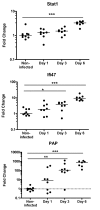Salmonella induces prominent gene expression in the rat colon
- PMID: 17850650
- PMCID: PMC2048963
- DOI: 10.1186/1471-2180-7-84
Salmonella induces prominent gene expression in the rat colon
Abstract
Background: Salmonella enteritidis is suggested to translocate in the small intestine. In vivo it induces gene expression changes in the ileal mucosa and Peyer's patches. Stimulation of Salmonella translocation by dietary prebiotics fermented in colon suggests involvement of the colon as well. However, effects of Salmonella on colonic gene expression in vivo are largely unknown. We aimed to characterize time dependent Salmonella-induced changes of colonic mucosal gene expression in rats using whole genome microarrays. For this, rats were orally infected with Salmonella enteritidis to mimic a foodborne infection and colonic gene expression was determined at days 1, 3 and 6 post-infection (n = 8 rats per time-point). As fructo-oligosaccharides (FOS) affect colonic physiology, we analyzed colonic mucosal gene expression of FOS-fed versus cellulose-fed rats infected with Salmonella in a separate experiment. Colonic mucosal samples were isolated at day 2 post-infection.
Results: Salmonella affected transport (e.g. Chloride channel calcium activated 6, H+/K+ transporting Atp-ase), antimicrobial defense (e.g. Lipopolysaccharide binding protein, Defensin 5 and phospholipase A2), inflammation (e.g. calprotectin), oxidative stress related genes (e.g. Dual oxidase 2 and Glutathione peroxidase 2) and Proteolysis (e.g. Ubiquitin D and Proteosome subunit beta type 9). Furthermore, Salmonella translocation increased serum IFN gamma and many interferon-related genes in colonic mucosa. The gene most strongly induced by Salmonella infection was Pancreatitis Associated Protein (Pap), showing >100-fold induction at day 6 after oral infection. Results were confirmed by Q-PCR in individual rats. Stimulation of Salmonella translocation by dietary FOS was accompanied by enhancement of the Salmonella-induced mucosal processes, not by induction of other processes.
Conclusion: We conclude that the colon is a target tissue for Salmonella, considering the abundant changes in mucosal gene expression.
Figures





Similar articles
-
Gene expression response of the rat small intestine following oral Salmonella infection.Physiol Genomics. 2007 Jul 18;30(2):123-33. doi: 10.1152/physiolgenomics.00190.2006. Epub 2007 Mar 20. Physiol Genomics. 2007. PMID: 17374845
-
Dietary fructo-oligosaccharides and lactulose inhibit intestinal colonisation but stimulate translocation of salmonella in rats.Gut. 2003 Nov;52(11):1572-8. doi: 10.1136/gut.52.11.1572. Gut. 2003. PMID: 14570725 Free PMC article.
-
Gene expression profiles of cardiomyocytes in rat autoimmune myocarditis by DNA microarray and increase of regenerating gene family.Transl Res. 2008 Sep;152(3):119-27. doi: 10.1016/j.trsl.2008.07.006. Epub 2008 Aug 20. Transl Res. 2008. PMID: 18774541
-
Gene expression responses to a Salmonella infection in the chicken intestine differ between lines.Vet Immunol Immunopathol. 2006 Dec 15;114(3-4):247-58. doi: 10.1016/j.vetimm.2006.08.007. Epub 2006 Sep 15. Vet Immunol Immunopathol. 2006. PMID: 16978708
-
Final report on the safety assessment of capsicum annuum extract, capsicum annuum fruit extract, capsicum annuum resin, capsicum annuum fruit powder, capsicum frutescens fruit, capsicum frutescens fruit extract, capsicum frutescens resin, and capsaicin.Int J Toxicol. 2007;26 Suppl 1:3-106. doi: 10.1080/10915810601163939. Int J Toxicol. 2007. PMID: 17365137 Review.
Cited by
-
Effects of mannoprotein E1 in liquid diet on inflammatory response and TLR5 expression in the gut of rats infected by Salmonella typhimurium.BMC Gastroenterol. 2010 Jun 8;10:58. doi: 10.1186/1471-230X-10-58. BMC Gastroenterol. 2010. PMID: 20529359 Free PMC article.
-
Animal Models of Type III Secretion System-Mediated Pathogenesis.Pathogens. 2019 Nov 22;8(4):257. doi: 10.3390/pathogens8040257. Pathogens. 2019. PMID: 31766664 Free PMC article. Review.
-
Alpha-defensins in enteric innate immunity: functional Paneth cell alpha-defensins in mouse colonic lumen.J Biol Chem. 2009 Oct 9;284(41):27848-27856. doi: 10.1074/jbc.M109.050773. Epub 2009 Aug 17. J Biol Chem. 2009. PMID: 19687006 Free PMC article.
-
Antagonistic activity of Lactobacillus acidophilus LA10 against Salmonella enterica serovar Enteritidis SE86 in mice.Braz J Microbiol. 2013 May 7;44(1):57-61. doi: 10.1590/S1517-83822013005000024. eCollection 2013. Braz J Microbiol. 2013. PMID: 24159284 Free PMC article.
-
The Gdac1 locus modifies spontaneous and Salmonella-induced colitis in mice deficient in either Gpx2 or Gpx1 gene.Free Radic Biol Med. 2013 Dec;65:1273-1283. doi: 10.1016/j.freeradbiomed.2013.09.013. Epub 2013 Oct 1. Free Radic Biol Med. 2013. PMID: 24090658 Free PMC article.
References
-
- Naughton PJ, Grant G, Spencer RJ, Bardocz S, Pusztai A. A rat model of infection by Salmonella typhimurium or Salm. enteritidis. J Appl Bacteriol. 1996;81:651–656. - PubMed
Publication types
MeSH terms
Substances
LinkOut - more resources
Full Text Sources
Other Literature Sources
Molecular Biology Databases
Research Materials

